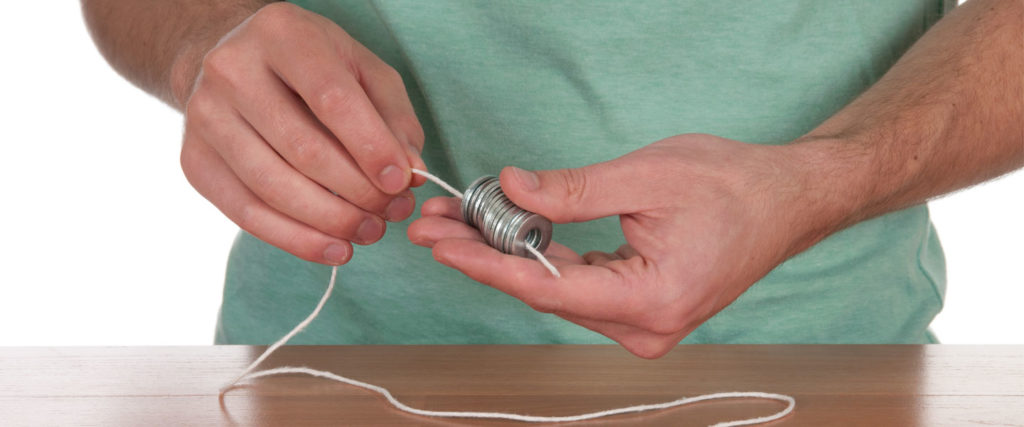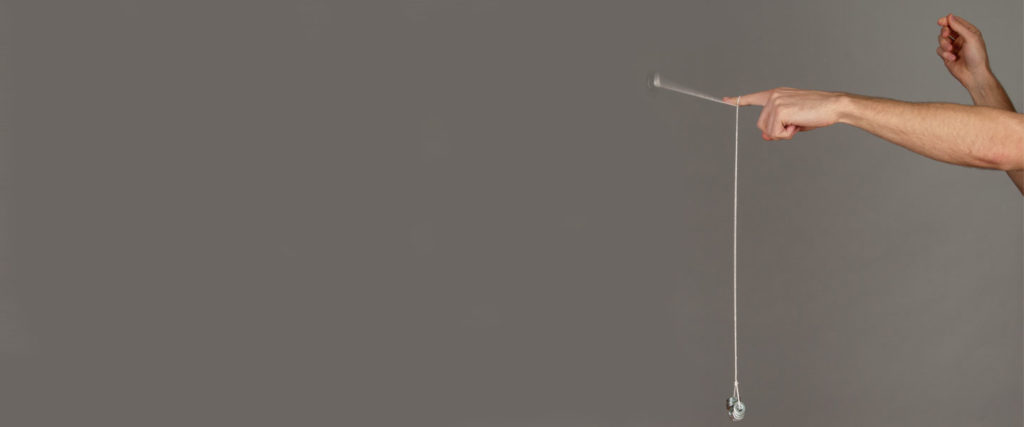Spinning Glasses of Water - Centripetal Force Board
When you swing a bucket of water over your head, you probably expect a big, wet rush of water to soak you as the bucket […]

It’s a classic comedy bit from the silent movie era. The villain hoists a piano to a third- or fourth-story window just waiting for the unsuspecting victim to stand below the precariously perched piano. The rope is cut, the piano crashes to the ground . . . but the victim always seems to stumble away in a daze. Okay, that’s the movies, but there is something interesting about a free-falling pendulum. So, get a piano, a rope, and an army of friends . . . okay, maybe not. First, try your luck with simple objects you can find around the house.

To get started, thread your string through 14 of the 15 metal washers.

Take the end of the string you just threaded through the metal washers and tie it back onto the string right above the stack of washers. Basically, you are making a small loop of string with washers on it.

Thread the other end of the string through the middle of the remaining washer and tie the string so that you have a string with 14 washers at one end and one washer at the other end. The ideal ratio of washers on the ends of the string is 14 to 1, and that’s just what you have.

With the string-washer apparatus you have constructed, grab the single-washer end with one hand and hang the heavy end of the string over your opposite hand’s pointing index finger.

Pull the single-washer end of the string so that the 14 washers are touching your pointing index finger. Make sure that the string is parallel or close to parallel with the ground.

From this position, let go of the single washer. Be sure to keep your pointing index finger as still as possible. Wait . . . the washers didn’t hit the ground. What happened? You’d better try it again to make sure that it wasn’t a fluke.
The apparatus that you’ve constructed out of some string and metal washers is a pendulum. A pendulum is a weight suspended from a pivot (or fixed point) so that it can swing freely, back and forth. A common example of pendulums can be found in such timepieces as grandfather clocks. The pendulum is the long piece below the clock face that swings slowly back and forth.
Through a lot of trial and error, we’ve discovered that the magic ratio of weight between the two objects at either end of the string should be about 14 to 1. That’s why you started with 15 metal washers. The key to making the trick more fun and interesting for your audience is to find two objects whose masses meet the 14-to-1 ratio requirement. Using the dinner table as the playground (so to speak), we found that our coffee cup and spoon obeyed the 14-to-1 rule. At this point, your wheels should be spinning as you think to yourself, “What object could be on the opposite end of the string from a 14-pound bowling ball?”
In terms of pure science, pendulums like the one you constructed operate using acceleration from gravity. When you release the single metal washer, gravity accelerates it toward the ground, giving it velocity. In a normal pendulum, the velocity decreases as the pendulum swings. The amplitude (how high the pendulum swings) also decreases the more the pendulum swings.
In our pendulum, the distance between the pivot (your finger) and the bob (the single washer) is decreased very rapidly when you release the string. As the distance between the bob and the pivot decreases, the velocity of the pendulum increases. With the velocity increasing so rapidly, its amplitude is increased to a point that it makes a number of full swings, wrapping the string around your finger. Friction keeps the group of metal washers from falling to the ground. With each turn around your finger, the friction increases and stops the fall of the large stack of washers.
Perhaps a simpler answer to why the dangling object seems to defy gravity is energy—kinetic energy and potential energy. Kinetic energy describes the energy of a moving object. Potential energy describes the stored energy in a stationary object. As in this activity, when you are holding the string tied to the metal washers in your fingers, both ends of the string have potential energy. Once you let go of the single washer, that potential energy turns into kinetic energy since the washer is moving. The washer falls a long way and builds up speed, or increases its kinetic energy, as it falls. The kinetic energy of the single washer is great enough to cause the end of the string to wrap itself around your finger.
Try doing the experiment with one key tied to one end of the string and a key ring of 14 keys tied to the other end of the string. Drape the string over a pencil (instead of your finger) and see if the same thing happens. To make it easy, use keys that are identical. If you don’t have 15 identical keys (and who does?), just make sure the keys are in approximately a 14-to-1 ratio (you’ll learn more about this all-important ratio in a minute).
Here’s another consideration. Try changing one variable at a time. Remember that you should change only one thing at a time so you can clearly see the effect of the change. If you change several variables at once, you won’t know which one caused the change. What happens if you change the weight of the objects? The ratio of the objects? The kind of string? The length of the string? So many questions, so much science!
Experiment with changing the incline angle of the string before you drop the metal washers. When the string is at a much sharper angle does the same thing happen as when the string is horizontally parallel to the ground?
If you use a pencil instead of your finger, does the surface of the pencil make a difference in the result? What happens when a pencil has ridges instead of a smooth surface?
Try dropping the pendulum from different heights using different lengths of string between your finger and the washers. Is there a point, either too high or too low,at which the magic of your pendulum no longer works? Is there a height that works better than in our original experiment?
How many washers can you add to the lighter side of the pendulum and still have it work? How few can you have on the heavier side?
On a personal note, I was trying to explain this cool demonstration to a group of friends at a dinner party. Unfortunately, I didn’t have a handful of metal washers, but we managed to scrounge up some string. Using only what we could find on the dinner table, the after-dinner scientists discovered the perfect relationship between a coffee cup and a spoon. This isn’t to say that all coffee cups and spoons fall into the 14-to-1 weight ratio rule, but you get the idea.
We also discovered that a wedding band and a wine glass share a 14-to-1 relationship. Again, not all wedding bands and wine glasses will work, but it’s fun to try! Tie the string to the stem of the wine glass and the wedding band. Drape the string over your finger, holding the wine glass upside down. Let go of the wedding band and watch what happens. Just be ready for some crash landings. If the coffee cup or the wine glass crash into the table, try adjusting the weight on the other end of the string, the length of the string, or the incline angle of the string. This is yet another example of when you should follow our motto, “Don’t try this at home . . . try it at a friend’s home.”
What if a television producer called you and wanted you to do this experiment on national TV? Dropping a washer isn’t all that exciting. What if he wanted you to use a car on one side of the “string”? What might you have to use on the other side of the “string” so that the car didn’t crash down onto an unsuspecting victim below? How long do you think the “string” would have to be and what should the “string” be made of? What would be the best incline angle for the “string”?
Granted, this is an extreme example, but if you’re a teacher, you might consider posing the question to your class. You’d get some interesting answers, and it would become clear whether the students understood the importance of the 14-to-1 ratio and the concepts behind the Unbelievable Pendulum Catch activity.